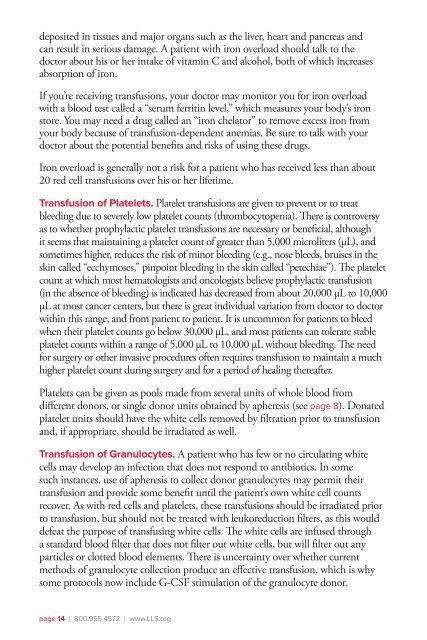Blood Transfusion (PDF) - The Leukemia & Lymphoma Society
Blood Transfusion (PDF) - The Leukemia & Lymphoma Society
Blood Transfusion (PDF) - The Leukemia & Lymphoma Society
Create successful ePaper yourself
Turn your PDF publications into a flip-book with our unique Google optimized e-Paper software.
deposited in tissues and major organs such as the liver, heart and pancreas and<br />
can result in serious damage. A patient with iron overload should talk to the<br />
doctor about his or her intake of vitamin C and alcohol, both of which increases<br />
absorption of iron.<br />
If you’re receiving transfusions, your doctor may monitor you for iron overload<br />
with a blood test called a “serum ferritin level,” which measures your body’s iron<br />
store. You may need a drug called an “iron chelator” to remove excess iron from<br />
your body because of transfusion-dependent anemias. Be sure to talk with your<br />
doctor about the potential benefits and risks of using these drugs.<br />
Iron overload is generally not a risk for a patient who has received less than about<br />
20 red cell transfusions over his or her lifetime.<br />
<strong>Transfusion</strong> of Platelets. Platelet transfusions are given to prevent or to treat<br />
bleeding due to severely low platelet counts (thrombocytopenia). <strong>The</strong>re is controversy<br />
as to whether prophylactic platelet transfusions are necessary or beneficial, although<br />
it seems that maintaining a platelet count of greater than 5,000 microliters (μL), and<br />
sometimes higher, reduces the risk of minor bleeding (e.g., nose bleeds, bruises in the<br />
skin called “ecchymoses,” pinpoint bleeding in the skin called “petechiae”). <strong>The</strong> platelet<br />
count at which most hematologists and oncologists believe prophylactic transfusion<br />
(in the absence of bleeding) is indicated has decreased from about 20,000 μL to 10,000<br />
μL at most cancer centers, but there is great individual variation from doctor to doctor<br />
within this range, and from patient to patient. It is uncommon for patients to bleed<br />
when their platelet counts go below 30,000 μL, and most patients can tolerate stable<br />
platelet counts within a range of 5,000 μL to 10,000 μL without bleeding. <strong>The</strong> need<br />
for surgery or other invasive procedures often requires transfusion to maintain a much<br />
higher platelet count during surgery and for a period of healing thereafter.<br />
Platelets can be given as pools made from several units of whole blood from<br />
different donors, or single donor units obtained by apheresis (see page 8). Donated<br />
platelet units should have the white cells removed by filtration prior to transfusion<br />
and, if appropriate, should be irradiated as well.<br />
<strong>Transfusion</strong> of Granulocytes. A patient who has few or no circulating white<br />
cells may develop an infection that does not respond to antibiotics. In some<br />
such instances, use of apheresis to collect donor granulocytes may permit their<br />
transfusion and provide some benefit until the patient’s own white cell counts<br />
recover. As with red cells and platelets, these transfusions should be irradiated prior<br />
to transfusion, but should not be treated with leukoreduction filters, as this would<br />
defeat the purpose of transfusing white cells. <strong>The</strong> white cells are infused through<br />
a standard blood filter that does not filter out white cells, but will filter out any<br />
particles or clotted blood elements. <strong>The</strong>re is uncertainty over whether current<br />
methods of granulocyte collection produce an effective transfusion, which is why<br />
some protocols now include G-CSF stimulation of the granulocyte donor.<br />
page 14 I 800.955.4572 I www.LLS.org

















